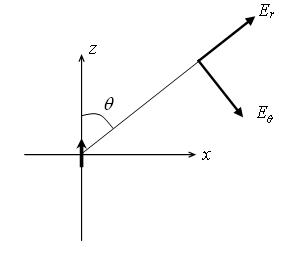The charge will move to and fro in a semicircular path, very much like a pendulum with its suspension at the origin.
A point-like electric dipole (dipole moment = p) is kept at the origin, pointing along the +z direction. A point charge q having mass m is released at rest from a point on the xy plane at a distance R from the origin. Assuming that only electrical forces act, determine the subsequent motion of the point charge.
-
UP 0 DOWN 0 5 33

33 Answers
sir post ur method pls and also tell the mistake in abv approach
i think its time to open up the ans to this Q :)
celestine, even in the polar form you should not get such a horrible equation.
but i am getting it !
also can u justify #13 and tell why #12 is wrong ?
sir i request u to post final ans and hide it
i want to cross check
ok that means #12 is true only
wow a semicircular path !
ok sir im workin on derivin that
i m using polar form
Z = rsin@
X= rcos@
d2Z/dt2 = kcos@/r3
d2X/dt2 = -2ksin@/r3
from abv
ksin2@/2r3 = (d@/dt)2r - d2r/dt2
k(1+sin2@)/r3 = 2r.dr/dt.d@/dt + rd2@/dt2
solving further i got #18
but puttin dr/dt =0 in abv eq im gettin a contradiction
so i assume my eqs are wrong ,but where is it wrong ?
note:
d2(rsin@)/dt2
= 2dr/dt .d@/dt cos@ + d2r/dt2sin@ + d2@/dt2. rcos@ - (d@/dt) 2 rsin@
d2(rcos@)/dt2
= 2dr/dt .d@/dt(-sin@) + d2r/dt2cos@ + d2@/dt2.(- rsin@) - (d@/dt) 2 (- rcos@)
representing as r,θ form
i am getting a scary equation like
r .d((dr/dθ) √3θ -sinθcosθ/r2 )dθ = (3θ - sin2θ )/√3θ - sinθcosθ
Is it right sir ?
also can u justify #13 and tell why #12 is wrong ?
well, the ques is interesting
but
i think that the motion that the charge will undergo should be oscillatory.( to and fro)..
do tell how u ppl are getting curved paths!...
and sir also tell how u hve kept the dipole? ( is its midpoint at the origin???, i think it should be ).....
Celestine, your mistake in #26 lies at the very beginning. You see d2z/dt2 is the acceleration along the z axis. So the correct equation should be
\dfrac{\mathrm{d}^2z}{\mathrm{d}t^2} = \dfrac{q}{m}(E_r\cos\theta -E_\theta \sin\theta)
and similarly for the second equation.
Here, \theta is measured from the direction of the dipole itself as shown below:
Apart from considering the force equations, we could take up the conservation laws. First of all, since the point charge is released on the xy plane, we could as well take it to be released from the point (R,0,0) itself. Thus, the initial potential energy is zero since for a dipole the potential is
V_\mathrm{dip} = \dfrac{p\cos\theta}{4\pi\epsilon_0 r^2}
and here \theta = 90^\circ. Also, the initial kinetic energy is zero. Since the system is closed, we have from the conservation of energy that for all (r,\,\theta),
\dfrac{1}{2}mv^2+\dfrac{pq\cos\theta}{4\pi \epsilon_0r^2}=0 -------------- (1)
Since the k.e is always positive, the second term must be negative implying that \cos\theta\leq 0. This means that the point charge is constrained to move in the region \dfrac{\pi}{2}\leq\theta\leq \dfrac{3\pi}{2}
Again, the torque of the electric force about the origin is responsible for the changing the angular momentum of the point charge:
\dfrac{\mathrm{d}}{\mathrm{d}t}(mrv_\theta)=qrE_\theta =\dfrac{pq\sin\theta}{4\pi \epsilon_0r^2} -------- (2)
Now, noting that v^2=v_r^2 + v_\theta^2
we get from (1), that
\dfrac{1}{2}m((rv_r)^2 + (rv_\theta)^2)+\dfrac{pq\cos\theta}{4\pi\epsilon_0}=0
Differentiating w.r.t time, we get
\dfrac{m}{2}\dfrac{\mathrm{d}}{\mathrm{d}t}(rv_r)^2 + rv_\theta \dfrac{\mathrm{d}}{\mathrm{d}t} (mrv_\theta)-\dfrac{pq\sin\theta}{4\pi\epsilon_0}\dfrac{\mathrm{d}\theta}{\mathrm{d}t}=0
Using the fact that vθ = r dθ/dt, we obtain from the above
\dfrac{m}{2}\dfrac{\mathrm{d}}{\mathrm{d}t}(rv_r)^2 + r^2\dfrac{\mathrm{d}\theta}{\mathrm{d}t} \dfrac{\mathrm{d}}{\mathrm{d}t} (mrv_\theta)-\dfrac{pq\sin\theta}{4\pi\epsilon_0}\dfrac{\mathrm{d}\theta}{\mathrm{d}t}=0
Dividing throughout by r2, we get
\dfrac{m}{2r^2}\dfrac{\mathrm{d}}{\mathrm{d}t}(rv_r)^2 + \dfrac{\mathrm{d}\theta}{\mathrm{d}t} \dfrac{\mathrm{d}}{\mathrm{d}t} (mrv_\theta)-\dfrac{pq\sin\theta}{4\pi\epsilon_0r^2}\dfrac{\mathrm{d}\theta}{\mathrm{d}t}=0
But because of (2), the last two terms cancel, and we are left with
\dfrac{\mathrm{d}}{\mathrm{d}t}(rv_r)^2 =0
That means that
rv_r=\textrm{ constant}
Since initially the charged particle was at rest, so the constant is zero. Accordingly
v_r=\dfrac{\mathrm{d}r}{\mathrm{d}t}=0
which gives us
r=\textrm{ constant}=R
Hence, the particle moves in a semi-circular path located in the region \dfrac{\pi}{2}\leq\theta\leq \dfrac{3\pi}{2}.
oops that was a major blunder i had been doing till know
i thought till now
formula for Er as that of Ez
oops sorry sir totally forgot abt this problem !!!!!!
tried only 5 mins and was going in the same direction .. should have continued ...
during subsequent motion,the position of point charge at any instant t is given by
z= -pqt2[unitvector k]/[8 pi epsilon0 R3m]
do u mean to say it can also be in z=0 ?
ok if i include that also wont it be correct ?
Also pls tell what kind of an ans u want from us , so that i can think in terms of that (makes job easier )
initially it will move in the -ve y axis direction then curve towards -ve x axis while continuing its motion along the y axis
Qualitatively i can say that its a bounded motion as
Mech energy = 0 initially
so PE <=0
it indirectly implies the charge is always in either -ve or +ve z axis as else PE wud change sign
the body goes to infinity? hmm... that's intereting.. how did u get that?
ok do u want us to show the final v attained when body goes to inf (thats easy) or find equation of trajectory ?
@cena
i used ax/ay = -2y/x
celestine how did u get that equation.........u wrote????.........u xplain it ...............i din read any such equation for dipoles...........
maybe even i know it without realizing....but as far as i think i don know how u got it.......so kindly xplain ur equation